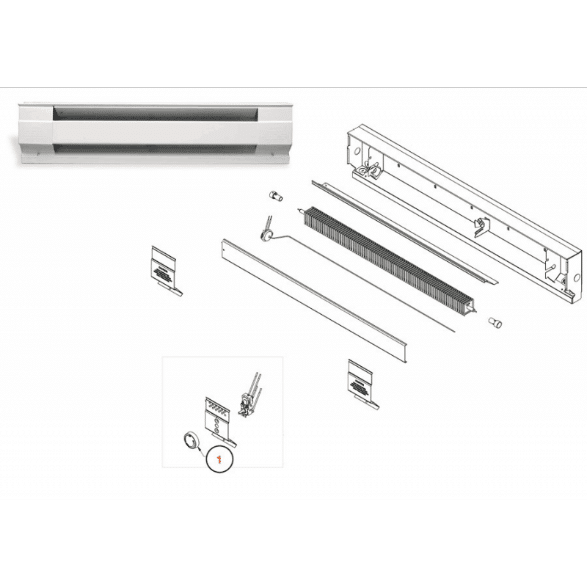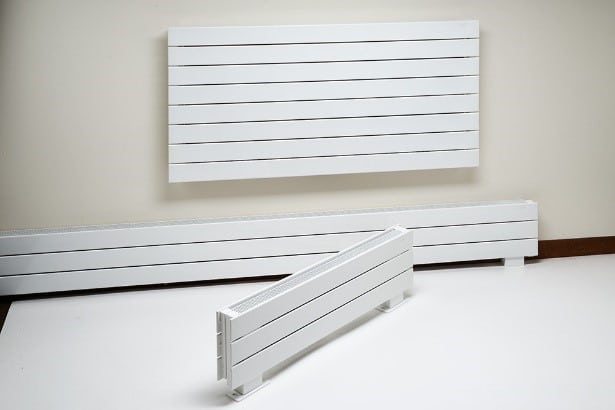FAQ
Frequently Asked Questions
1) How are these different from products like traditional electric baseboards, similar to what I find at big box stores or through a local electric heat distributor?
Runtal Electric Baseboards and Wall Panels are very different from the traditional electric baseboard design. Most, if not all baseboard products on the market consist of several pieces which snap together
Sheet Metal back plate
Front cover which snaps on to the backplate (Usually the sheet metal is very light gauge 22ga (thin).
Heating element is hung inside the enclosed cavity made by the backplate and front cover.
In some cases, the backplate and front cover are made from plastic rather than thin sheet metal.
Runtal Electric Baseboard and Wall Panels are one solid unit constructed of heavy gauge (16 GA) fully welded steel. The entire unit is then powder coat painted for an elegant and extremely durable finish.
Traditional Sheet metal Electric baseboard:

Runtal Electric Baseboard – Fully welded, one-piece design:

2) Are they more efficient than traditional baseboard?
Runtal Electric units are 100% efficient. What this means is that 100% of the electric energy used is converted into heat. Traditional baseboard products utilize lightweight construction which does not hold heat. As a result, when the room temperature is reached, they turn off and stop transmitting warmth into space whereas Runtal Electric products “store heat” because of the heavy steel construction which continues to radiate heat well after the room temperature has been satisfied. As a result, Runtal Electric Baseboard and Wall Panels do not have to continue to cycle on and off like a traditional electric baseboard product would do.
3) How do they heat? Are they filled with water?
Runtal Electric Baseboard and Wall Panels utilize what is called a Mica Insulated Strip Finned (MISF) heating element. This high-tech element requires no fluid filled tubes or pipes because the element is secured in direct contact with the heavy-duty metal radiator body. The MISF element is 100% efficient, transferring all of its electrical energy into heat which is in direct contact to the radiator surface. This direct contact efficiently heats up the heavy mass of the welded steel body of the unit and produces radiant (like standing in the sun) heat along with convective heat flow (Aero fins on the back of the unit provide natural heated air flow because hot air rises)
In some traditional electric baseboard products, the element (separate from the enclosure) contains an antifreeze or “oil” fluid. When electricity is applied, a rod like element encapsulated in the fluid gets hot and heats the fluid which then heats the fins on the pipe, which then heats the air. Traditional baseboard has NO radiant effect. All of the heat to the room is transfer by convection (hot air rises).
4) How much do electric radiators cost to run?
Operating costs vary based on your electricity costs, and the region of the country you are located in. Compared to standard electric baseboard, Runtal products will generally require the same amount of electricity to operate, however based on the heavy steel construction and the radiant effect which Runtal Electric Baseboard and Wall Panels provides, they will need to be energized (operate) less often for two reasons as shown below. In this regard, less operating time = less energy used to reach comfort.
A: Once the Runtal Electric Baseboard heats up, the heavy steel body of the baseboard acts as a “heatsink”, storing heat.
B: Runtal Electric Baseboard operates by using both radiant heat transfer, as well as convective heat transfer. The radiant effect (like standing in the sun) often means comfort levels are reached at lower air temperatures, and thus requires less energy to be comfortable than products which heat only the air in the space.
.
5) Why do they cost more than standard electric baseboard?
Runtal Electric Baseboard and Wall Panels are completely different from standard electric baseboard products in construction, durability, and quality finish and are not directly comparable. For more information on construction and operating differences please see answers to questions 1 through 4.
Concerning product fit and finish there is no product currently on the market which can match the design beauty and quality of the Runtal product line.
6) How many feet would I need to heat a room?
Depending on what area of the country you live in, and how the room is constructed and what your specific design requirements are, we can offer you a perfect solution for both comfort and architectural beauty from our collection of Runtal Electric Baseboard, Wall Panels of Towel Radiators.
7) Do they have an integral thermostat?
Runtal Electric Baseboard and Wall Panels do not have an integral thermostat. Unit mounted thermostats are not recommended for proper room comfort levels. Rather we recommend the Runtal Smart Thermostat (RST), which is fully Wi-Fi enabled and can be programmed for the ultimate room comfort and operating efficiency. See RST Thermostat
The reason unit mounted thermostats are not recommended is because the thermostat will measure the temperature in which it is located, in this case directly on the unit. This will mean that only the area directly around the unit will remain warm, whilst the rest of the room will be cold.
8) Are they available in plug in versions?
No, Runtal Electric Baseboard and Wall Panels require direct hard wiring. For replacement of existing baseboard, in most cases the Runtal Electric products can utilize the existing wiring. (Note: Although it is a fairly simple job, we strongly recommend that a certified electrician wire the products in order to meet local building and electric codes. All Runtal Electric products are UL/CSA certified.
9) Which voltage do I want?
This will depend on the existing voltage which your building currently utilizes. Runtal Electric Baseboard and Wall Panels are available in 120V, 240V and 208V models.
10) How do I know what size I need?
See question 7
11) Is there a suggested thermostat?
See question 8
12) How hot to the touch do they get?
Under normal conditions (room temperature 68 degrees) Runtal Electric Baseboards will reach a limited surface temperature of 140 degrees F. Runtal Wall Panels will reach between 160 and 170 degrees F.
13) Will my drapes get scorched?
No, your drapes will not scorch. We recommend no less than 2” of clearance between any object (furniture, curtains) to avoid direct contact with the Runtal Electric Baseboard of Wall Panel.
14) Can I put them behind the furniture?
Yes, however be sure to maintain at least 2” of clearance between the surface of the Runtal Electric Baseboard or Runtal Electric Wall Panel.
15) Do our Electric Radiators make noise?
NO – Runtal Electric Baseboard and Electric Wall Panels operate with no noise at all. When first installed and energized you may hear some “ticks” as the unit expands, however all of our products are fully tested prior to shipment, therefore any expansion should have already been set at the factory.
16) What’s the difference between the Wall Mounted Baseboard Series and the Free-Standing Baseboard Series
Runtal Electric Baseboard is available in two different mounting styles:
Runtal Electric Baseboard is available in two different mounting styles:
Wall Mounted – Runtal Electric Wall Mounted products are designed to be fixed to the wall, similar to traditional baseboard. Because the product is heavy, the weight is supported on each end by small boxes “feet” which also serve as the wiring connection points for the unit.
Freestanding – Runtal Electric Freestanding Baseboard (sometimes referred to as Pedestal Mounted) does not need a wall to support it. The Freestanding Series is secured to the floor rather than the wall, which allows for applications where a wall surface is not present. For example, in the case of floor to ceiling windows. The Freestanding Series comes in two parts:
A: The Electric Baseboard itself.
B: The Pedestal Mounting system.
This Pedestal Mounting system is actually a “false” back which is constructed in exactly the same way the baseboard product is (fully welded and looks exactly the same as the baseboard). With this Series, the baseboard has two completely finished sides so when viewed from either side, it is a fully finished unit.
17) How much heat do I need in my space?
Generally, most spaces will require 10 Watts (35 BTU/H) per square foot area of the space. Using this as a baseline and evaluating the considerations below will give a solid idea of the heating requirements.
To calculate the baseline requirement:
1) Room width x room length = Square foot area
2) Square foot area x 10 = total watts of heat required
Example:
- Room width = 12 Feet
- Room Length = 12 feet
- 12 x 12 = 144 Square Feet
- 144 x 10 = 1440 Watts
This result is the total amount of heat required to properly heat the space.
3) Selecting the product, you want:
If there is available space along an outside wall with windows, our EB3 Wall Mounted Baseboard is perfect. Selecting from the “specification – installation” section of the website for “Wall Mounted Baseboard” we see that a 120” (10 foot) EB3 model will meet our heating requirements of 1440 Watts.
Baseboard Heating Capacities (BTUH) Chart:

Any combination of lengths can also be used if a single 120” (10-foot) Runtal Electric Baseboard will not meet your design requirements. For example, using two separate 60” (5 foot) will meet the heating requirements also (733 Watts ea.)
Sizing Considerations
Insulation and Window exposure – Depending on your building’s construction, and how old it is, the amount of insulation will vary. For buildings with questionable insulation, more heat will be required to meet comfort levels. As a general rule of thumb, add 10% to 15% more wattage to the baseline calculation above. This general rule also applies to windows. If you have older windows which tend to leak cold air, or you have particularly large windows, add 10% – 15% more wattage to the baseline calculation.
High Ceilings – The baseline calculation assumes a standard celling height of 96” (8 feet). For applications where you have higher ceilings in the room, or cathedral type ceilings add the following percentage of heat to the baseline calculation

Store
Purchase any of our handcrafted stocked Runtal White radiators directly from the factory, for quick delivery, or choose from a variety of 9 standard colors for 2-week delivery.
Design Assistance & Custom Products
Runtal Radiators can be custom designed to fit your exact specifications. Choose from an endless variety of colors, including select metallic finishes. Our experts will assist you with finding the exact size, heat capacity and décor your are looking for.
